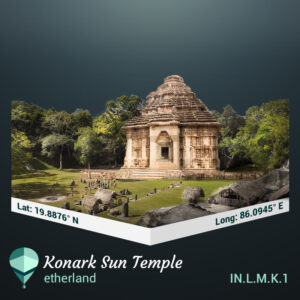 Ordered by King Narasimhadeva I in 1250 CE, the Konark Sun Temple is dedicated to the Hindu Sun God Surya. Even though the left part of the temple was completely destroyed, the remaining 30 meters high structure is incredibly well preserved. Having the appearance of a gigantic chariot laying on 24 wheels carved in stone, it is one of the rare Asian temples with known early history. In fact, details of its early years were found written in Sanskrit on palm leaf manuscripts in the 1960s.
Ordered by King Narasimhadeva I in 1250 CE, the Konark Sun Temple is dedicated to the Hindu Sun God Surya. Even though the left part of the temple was completely destroyed, the remaining 30 meters high structure is incredibly well preserved. Having the appearance of a gigantic chariot laying on 24 wheels carved in stone, it is one of the rare Asian temples with known early history. In fact, details of its early years were found written in Sanskrit on palm leaf manuscripts in the 1960s.
On the coast of the Bay of Bengal in the Indian city of Odisha, Konark Sun Temple is located in the historic town of Konarak. It is an ornately sculpted temple built in the 13th century to honor the Sun God, Surya. Locally known as Konark Surya Mandir, King Narasimhadeva I of the Eastern Ganga dynasty made it to represent the Sun God via a magistral monument.
The temple holds religious importance given the legend of Samba. According to beliefs in Hinduism, Samba, the son of Hindu deity Krishna, was cursed into Leprosy by his father when Krishna believed a false accusation against his notorious son. As the truth of his son’s innocence came out, Krishna advised his son to pray to the Sun God, who was the only one capable of curing Samba of his deadly disease. To cure his illness, Samba spent 12 years worshiping the Sun God until he was cured. Samba built the Konark Temple in honor of the Sun God to celebrate his successful recovery. To remember the occasion, Hindus started the tradition of Chandrabhaga Melaelan, where believers gather in Konark Sun Temple and worship the Sun. Since then, this day has held significance as people believe that the Sun will cure diseases and gather to pray for their health.
The ancient temple was built in 1250. The design represents the chariot of the Sun God by twelve pairs of carved stone wheels with seven stone horses. The 24 wheels from the twelve pairs of wheels also symbolize the months of the Hindu calendar, while seven symbolize the week’s seven days. Others argue that seven represents the seven colors of light. The stones are fit and finished so perfectly that the joints are not visible to an unaided eye. The carving on these exterior stones of the temple showcase different sculptured decorations of mythical creatures, animals, humans, and abstract.
The idol of Sun God is wearing a lower garment and many ornaments, including a necklace, armlets, earrings, and a crown. It is the only idol of a god in India that is wearing boots. The hair is shown worn in a bun on the top of the head. In his hands, he holds lotus stalks and is surrounded by many dancing figures.
Like most of the temples in Hinduism, Konark Sun Temple is square-shaped. The temple’s interior contains a crown, an audience hall, a dance hall, and a tower. The architecture of the temple is so classic, grand, and sharp. For an observer standing inland during the dawn or dusk, the chariot structure appears to emerge from the depths of the Bay of Bengal carrying the Sun.
After being built in 1250, the temple has not gone through any complete reconstruction process. Even though the attack by invaders and nature has left the temple in ruins, it still manages to attract hundreds of adherents and visitors for its grandeur and essence. For its Historical significance and cultural relevance, the temple was included in the UNESCO World Heritage Sites in 1984. This temple also made it to the list of the seven wonders of India and appeared on the backside of the 10 Indian rupee note.
The history preserved in the ruins of the Konark Sun Temple still manages to attract Hindu pilgrims and tourists. It is often used as a cultural venue for classical Indian dance performances promoting India’s cultural and historical affluence.